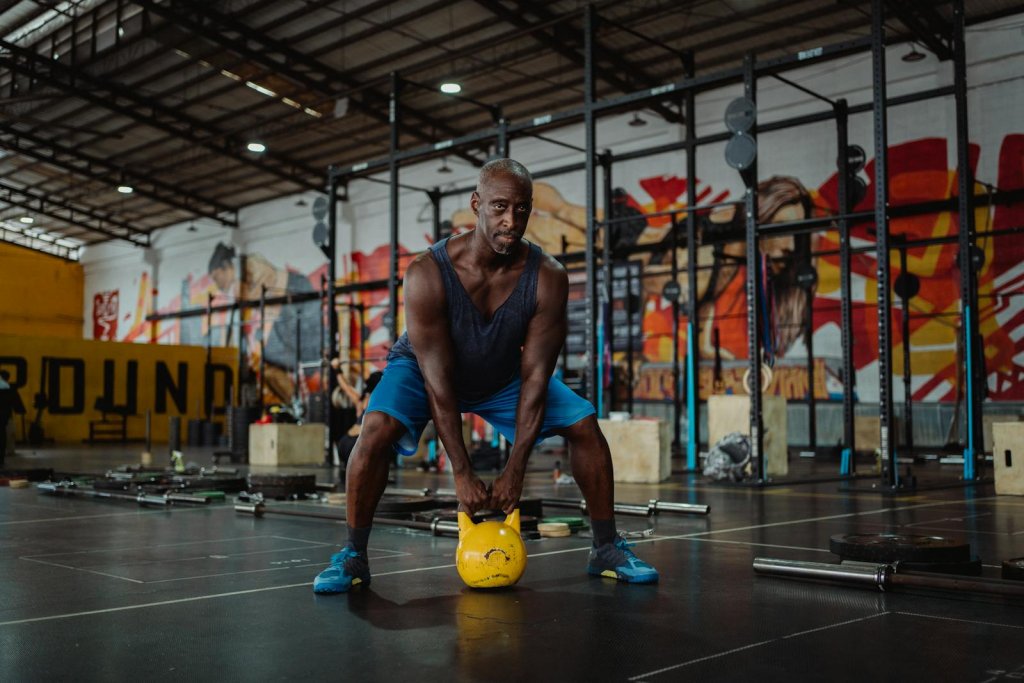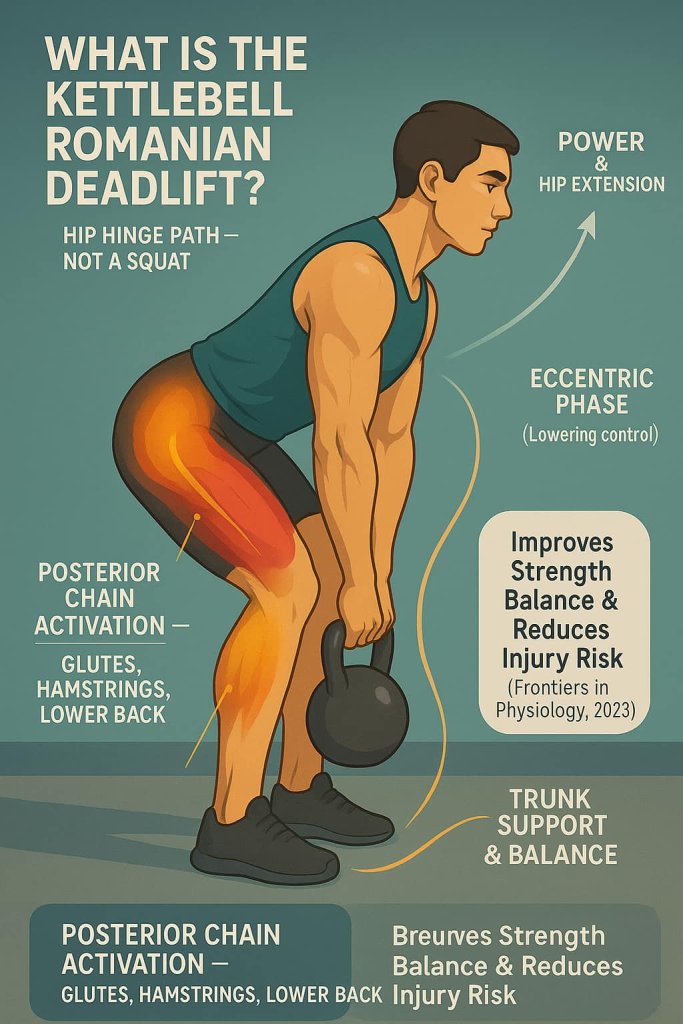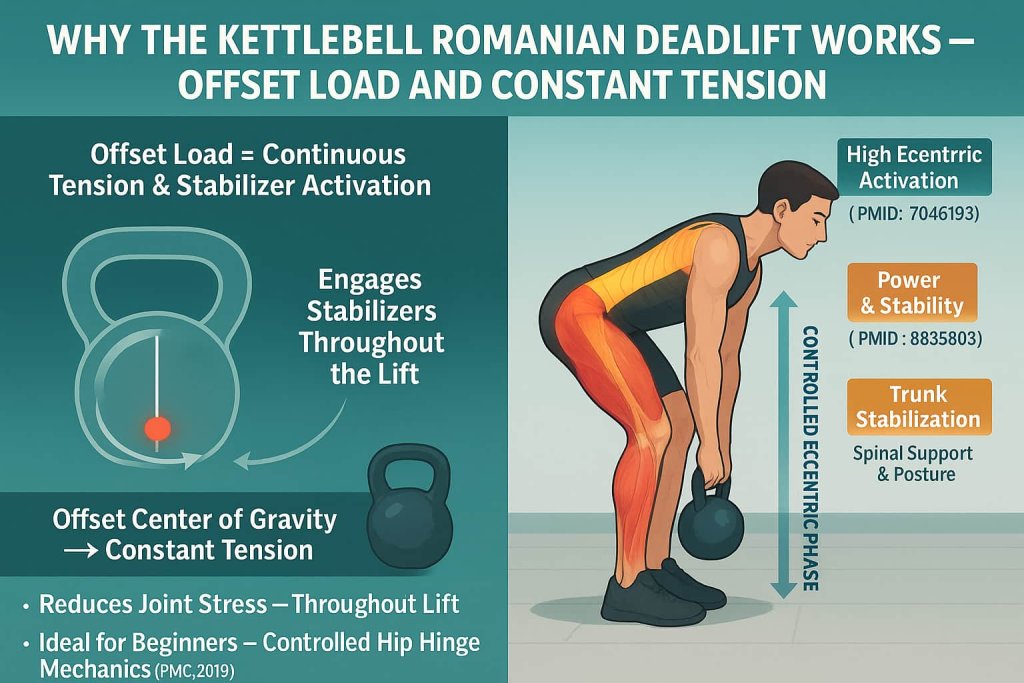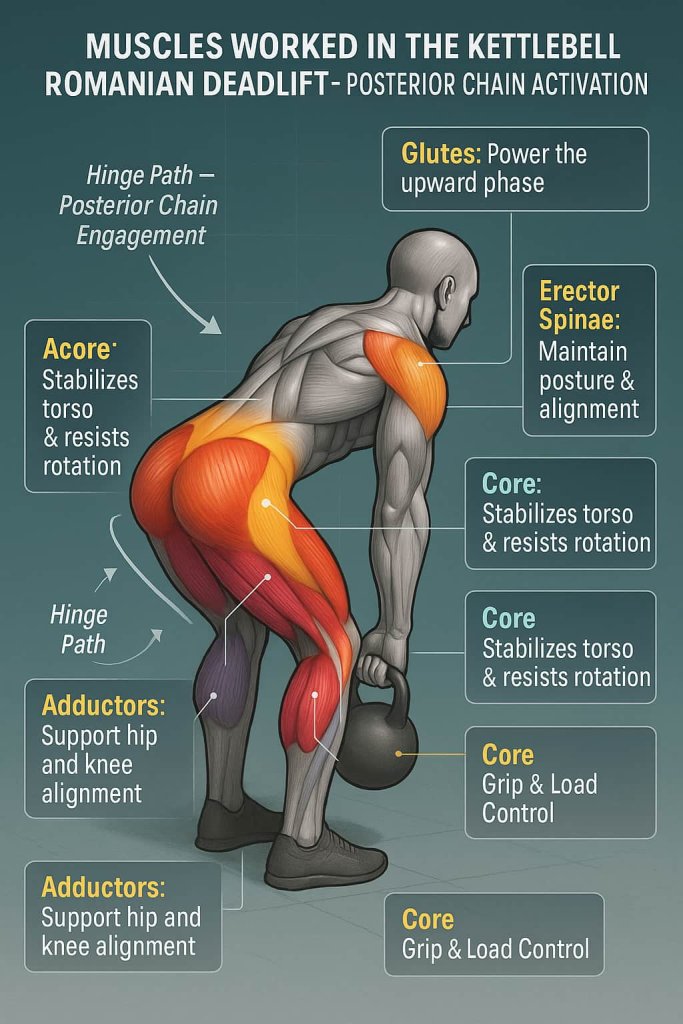The Kettlebell Romanian Deadlift (RDL) strengthens your glutes, hamstrings, and lower back through a controlled hip hinge—without needing heavy barbells.

This movement is a safer, more accessible alternative to traditional barbell deadlifts while still delivering powerful posterior-chain activation. Understanding how and why it works helps you build functional strength, improve posture, and prevent injuries—all with just one kettlebell.
What Is the Kettlebell Romanian Deadlift?
The kettlebell Romanian deadlift (K-RDL) is a hinge-based strength exercise that targets your posterior chain—the muscles along the back of your body, including the hamstrings, glutes, and lower back.

Unlike a conventional deadlift, the RDL focuses on the eccentric (lowering) phase, promoting flexibility, control, and muscular endurance.
Why It Matters
- Builds strong glutes and hamstrings without spinal overload.
- Reinforces hip hinge mechanics critical for safe lifting.
- Improves balance, stability, and athletic performance.
- Reduces hamstring strain risk by training eccentric control.
A 2023 Frontiers in Physiology study confirmed that eccentric hamstring training (like the RDL) improves strength balance and lowers injury risk in athletes.
Why the Kettlebell Romanian Deadlift Works
The K-RDL works because of its offset load and constant tension. The kettlebell’s center of gravity hangs below the handle, forcing stabilizers to stay engaged throughout the lift.

Key Benefits:
- Increased hamstring activation: EMG studies show higher semitendinosus activation than other posterior-chain lifts.
- Glute engagement: Step variations and single-leg RDLs further boost gluteus maximus activation (PMID).
- Improved posture and spinal control: Strengthens erector spinae to support neutral alignment.
- Joint-friendly training: Reduces compressive stress on knees and spine versus barbell alternatives.
According to PMC (2019), kettlebell RDLs are especially valuable for beginners learning to hinge correctly while minimizing injury risk.
How to Do the Kettlebell Romanian Deadlift
Step-by-Step Instructions
- Start Position:
- Stand with feet hip-width apart, kettlebell between your feet.
- Hold the handle with both hands, arms straight, shoulders back.
- Engage Core:
- Brace your abs and keep a soft bend in your knees.
- Pull your shoulder blades slightly back and down.
- Hinge Movement:
- Push hips backward while keeping the kettlebell close to your legs.
- Lower until you feel tension in your hamstrings (mid-shin level).
- Return to Start:
- Drive hips forward, squeeze glutes, and return to standing tall.
- Avoid hyperextending your back at the top.
Trainer Tip
- Focus on hip movement, not knee bend.
- Maintain a neutral spine—avoid rounding your back.
- Move slowly and with control for best muscle activation.
Muscles Worked in the Kettlebell Romanian Deadlift
| Primary Muscles | Supporting Muscles |
|---|---|
| Gluteus Maximus | Erector Spinae |
| Hamstrings (Biceps Femoris, Semitendinosus, Semimembranosus) | Core (Transverse Abdominis, Obliques) |
| Adductor Magnus | Forearms & Grip Muscles |

Muscle Function
- Hamstrings: Control the descent and drive hip extension upward.
- Glutes: Provide power and hip stability at lockout.
- Erector Spinae: Maintain spinal alignment throughout the hinge.
- Core: Stabilizes the torso and resists rotation.
Common Mistakes to Avoid
- Rounding the back: Keep chest lifted and spine neutral.
- Squatting instead of hinging: Push hips backward, not downward.
- Letting kettlebell drift forward: Keep it close to your legs.
- Overextending at the top: Finish tall but don’t lean back.
Programming Variables
- Frequency: 2–3 times per week
- Sets/Reps: 3–4 sets × 8–12 reps
- Tempo: 3 seconds down, 1 second up
- Rest: 60–90 seconds between sets
- Progression: Increase load, perform single-leg or deficit variations
Variations & Progressions
1. Bodyweight Single-Leg Romanian Deadlift (SLRDL)
Why It Works
The Bodyweight SLRDL teaches proper hip hinge mechanics, balance, and posterior-chain activation without added load. It’s ideal for beginners or as part of a warm-up before weighted training.
By working one leg at a time, it improves coordination, stability, and reduces muscular imbalances between sides.
Muscles Worked
- Gluteus Maximus
- Hamstrings (Biceps Femoris, Semitendinosus, Semimembranosus)
- Erector Spinae
- Core (Transverse Abdominis, Obliques)
- Gluteus Medius and Adductors (for stability)
How to Do It
- Stand tall with feet hip-width apart and hands by your sides.
- Shift weight onto one leg and engage your core.
- Hinge at the hips, extending the opposite leg straight behind you.
- Lower your torso until it’s almost parallel to the floor — keep your spine neutral.
- Pause briefly, then drive your hips forward to return to standing.
- Repeat on the other leg.
Trainer Tip
Keep your hips square to the floor — avoid twisting or opening the lifted leg. Move slowly and with control to feel tension in your hamstrings and glutes.
2. Single-Leg Kettlebell Romanian Deadlift
Why It Works
This variation combines balance, coordination, and load to develop unilateral strength and stability.
It enhances glute and hamstring engagement while improving ankle, knee, and hip joint control—critical for runners and athletes.
Muscles Worked
- Gluteus Maximus (primary mover)
- Hamstrings
- Gluteus Medius
- Core and Lower Back Stabilizers
- Forearms and Grip Muscles
How to Do It
- Hold a kettlebell in one hand (same side or opposite of working leg).
- Stand tall and balance on one leg with a soft knee bend.
- Hinge at the hips, extending the non-working leg behind you.
- Keep the kettlebell close to your standing leg as you lower it.
- Drive your hips forward to return to standing, squeezing your glutes.
- Perform equal reps on both sides.
Trainer Tip
Keep your shoulders and hips aligned. If you lose balance, touch your back foot lightly to the floor between reps to reset stability.
3. Double Kettlebell Romanian Deadlift
Why It Works
The Double Kettlebell RDL increases total loading and symmetrical strength.
It engages both sides evenly, enhancing grip, core stability, and total-body tension while maintaining a joint-friendly load compared to barbell lifts.
Muscles Worked
- Gluteus Maximus and Hamstrings
- Erector Spinae
- Core (Transverse Abdominis, Obliques)
- Forearms and Grip Muscles
How to Do It
- Stand with feet hip-width apart, holding a kettlebell in each hand in front of your thighs.
- Soften your knees slightly and brace your core.
- Push hips backward as you lower both kettlebells along your legs to mid-shin level.
- Maintain a neutral spine throughout.
- Drive hips forward, squeezing glutes at the top.
Trainer Tip
Control the descent — don’t bounce at the bottom. Keep the kettlebells close to your body to protect your lower back.
4. Deficit Kettlebell Romanian Deadlift
Why It Works
The Deficit K-RDL increases the range of motion by elevating your feet on a small platform or plates.
This deeper hinge stretches your hamstrings more effectively, enhancing flexibility, eccentric strength, and control.
Muscles Worked
- Gluteus Maximus
- Hamstrings (emphasized through extended stretch)
- Erector Spinae
- Core Stabilizers
How to Do It
- Stand on a low platform (2–4 inches high) with a kettlebell in both hands.
- Engage your core and slightly bend your knees.
- Hinge hips back, lowering the kettlebell below foot level while keeping a neutral spine.
- Pause briefly at the bottom, then drive hips forward to return to standing.
- Repeat for controlled reps.
Trainer Tip
Don’t chase depth — stop before your lower back rounds. Move slowly to feel the full stretch and contraction in your hamstrings.
Safety & Precautions
- Warm up with hip mobility drills and glute activations before lifting.
- Avoid excessive load if you have lower back pain or hamstring tightness.
- Keep the weight moderate until hinge mechanics are mastered.
- Consult a physical therapist if you experience pain during the exercise.
FAQs About the Kettlebell Romanian Deadlift
1. Is the kettlebell Romanian deadlift good for beginners?
Yes—its lighter, centered load helps teach safe hip-hinge mechanics and balance.
2. How is it different from a regular deadlift?
The RDL uses less knee bend and focuses on the hamstrings and glutes instead of full-body pulling power.
3. What weight should I start with?
Start with 8–12 kg (18–26 lb) for women and 12–16 kg (26–35 lb) for men, adjusting based on control and form.
4. Can it replace barbell deadlifts?
It’s an excellent alternative for improving posterior-chain strength with lower spinal stress.
5. Should I feel it in my lower back?
You’ll feel engagement—but not strain. If pain occurs, check your hinge form and reduce the load.
6. Is the K-RDL effective for runners or athletes?
Yes—it strengthens hamstrings eccentrically, improving stride power and reducing strain injuries.
7. Can I do this at home?
Absolutely—one kettlebell and a small space are all you need.
Conclusion
The Kettlebell Romanian Deadlift is a simple yet powerful way to strengthen your posterior chain, improve posture, and enhance athletic performance—all without heavy barbells.
Focus on form, hinge mechanics, and consistency, and you’ll develop balanced strength that supports every movement you make.
Train smart—master your hinge, and your strength will follow.
References
- Martín-Fuentes I, et al. (2020). Electromyographic activity in deadlift exercise and its variants. PLOS ONE.
https://journals.plos.org/plosone/article?id=10.1371/journal.pone.0229507 - Coratella G, et al. (2022). An electromyographic analysis of Romanian, step-Romanian, and stiff-leg deadlifts. International Journal of Environmental Research and Public Health.
https://www.mdpi.com/1660-4601/19/3/1903 - Andersen V, et al. (2021). Comparison of muscle activity in three single-joint, hip-extension exercises in resistance-trained women (includes RDL). Journal of Functional Morphology and Kinesiology (PMC).
https://pmc.ncbi.nlm.nih.gov/articles/PMC8057707/ - Meigh NJ, et al. (2019). Kettlebell training in clinical practice: a scoping review. BMC Sports Science, Medicine and Rehabilitation.
https://bmcsportsscimedrehabil.biomedcentral.com/articles/10.1186/s13102-019-0130-z - Govindasamy K, et al. (2024). Kettlebell training vs. bodyweight resistance training in obese adults: randomized trial. BMC Sports Science, Medicine and Rehabilitation.
https://bmcsportsscimedrehabil.biomedcentral.com/articles/10.1186/s13102-024-00894-6 - Zhang Y, et al. (2024). The impact of eccentric training on athlete movement speed: systematic review. Frontiers in Physiology (PMC).
https://pmc.ncbi.nlm.nih.gov/articles/PMC11671480/
This content is for informational purposes only and not medical advice.
